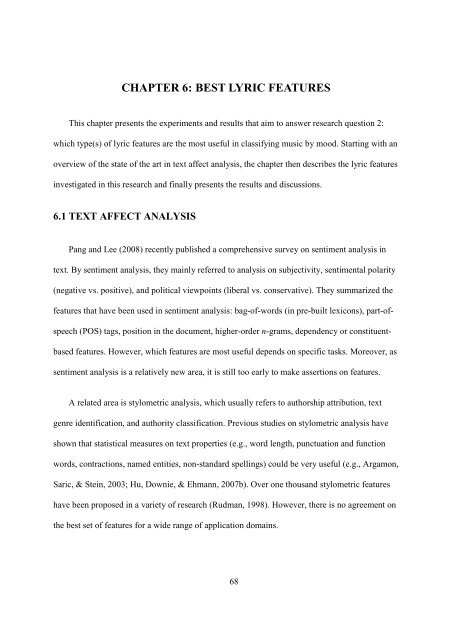improving music mood classification using lyrics, audio and social tags
improving music mood classification using lyrics, audio and social tags
improving music mood classification using lyrics, audio and social tags
You also want an ePaper? Increase the reach of your titles
YUMPU automatically turns print PDFs into web optimized ePapers that Google loves.
CHAPTER 6: BEST LYRIC FEATURES<br />
This chapter presents the experiments <strong>and</strong> results that aim to answer research question 2:<br />
which type(s) of lyric features are the most useful in classifying <strong>music</strong> by <strong>mood</strong>. Starting with an<br />
overview of the state of the art in text affect analysis, the chapter then describes the lyric features<br />
investigated in this research <strong>and</strong> finally presents the results <strong>and</strong> discussions.<br />
6.1 TEXT AFFECT ANALYSIS<br />
Pang <strong>and</strong> Lee (2008) recently published a comprehensive survey on sentiment analysis in<br />
text. By sentiment analysis, they mainly referred to analysis on subjectivity, sentimental polarity<br />
(negative vs. positive), <strong>and</strong> political viewpoints (liberal vs. conservative). They summarized the<br />
features that have been used in sentiment analysis: bag-of-words (in pre-built lexicons), part-ofspeech<br />
(POS) <strong>tags</strong>, position in the document, higher-order n-grams, dependency or constituentbased<br />
features. However, which features are most useful depends on specific tasks. Moreover, as<br />
sentiment analysis is a relatively new area, it is still too early to make assertions on features.<br />
A related area is stylometric analysis, which usually refers to authorship attribution, text<br />
genre identification, <strong>and</strong> authority <strong>classification</strong>. Previous studies on stylometric analysis have<br />
shown that statistical measures on text properties (e.g., word length, punctuation <strong>and</strong> function<br />
words, contractions, named entities, non-st<strong>and</strong>ard spellings) could be very useful (e.g., Argamon,<br />
Saric, & Stein, 2003; Hu, Downie, & Ehmann, 2007b). Over one thous<strong>and</strong> stylometric features<br />
have been proposed in a variety of research (Rudman, 1998). However, there is no agreement on<br />
the best set of features for a wide range of application domains.<br />
68
















